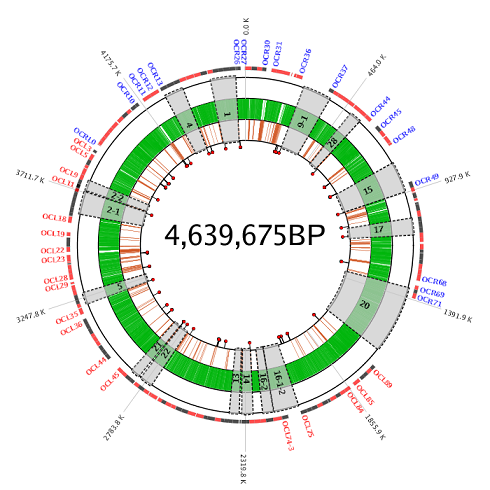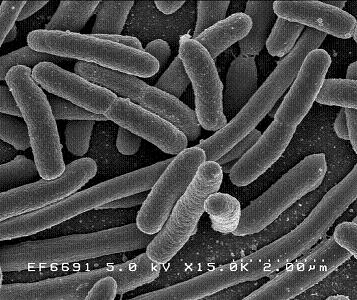Escherichia coli: Difference between revisions
(References) |
No edit summary |
||
| Line 29: | Line 29: | ||
This is a figure illustrating the comeplete genome of ''E. coli'' from National BioResource Project (NBRP).[http://www.shigen.nig.ac.jp/ecoli/strain/top/top.jsp] | This is a figure illustrating the comeplete genome of ''E. coli'' from National BioResource Project (NBRP).[http://www.shigen.nig.ac.jp/ecoli/strain/top/top.jsp] | ||
Moreover, there are many different strains of ''E. coli''; each of these strains differs in its genotype from wild-type ''E. coli''. The genotype will then affect the phenotype that is expressed, and further influences the physiology and lifecycle of the each strain. Therefore, different strains of ''E. coli'' can live in different kinds of animals. The natural biological process of mutation in genome is the major cuase to produce so many differnet strains of ''E. coli''. | |||
==Cell Structure and Metabolism== | ==Cell Structure and Metabolism== | ||
Revision as of 12:57, 5 June 2007
A Microbial Biorealm page on the genus Escherichia coli
Classification
Higher order taxa
Eubacteria (Kingdom); Bacteria (Domain); Proteobacteria (Phylum); Gamma Proteobacteria (Class); Enterobacteriales (Order); Enterobacteriaceae (Family); Escherichia (Genus)
Species
Escherichia coli
Description and Significance
E. coli was first discovered in 1885 by Theodor Escherich, a German bacteriologist. E. coli then had have been used commonly for biological lab experiment and research. E. coli is a Gram-negative organism that has the disability to sporulate. Therefore, it is easy to decrease its eradicaton by simple boiling or basic sterilization. E. coli can also be classified into hundreds of strains on the basis of different serotypes. E. coli O157:H7, for example, is a well-studied strain of the bacterium E. coli, which produces Shiga-like toxins, causing severe illness by eating cheese and contaminated meat[1]. Furthermore, enteric E. coli can be classified into six categories based on its virulence properties, such as enterotoxigenic E. coli (ETEC), enteropathogenic E. coli (EPEC), enteroinvasive E. coli (EIEC), enterohemorrageic E. coli (EHEC), enteroadherent aggregative E. coli (EAggEC), and verotoxigenic E. coli (VTEC)[2]. These enteric E. coli can cause several intestinal and extra-intestinal infections such as urinary tract infection and mastitis. However, E. coli are not always harmful to human bodies or other animals. Most E. coli live in our intestines, where they help our body breakdown the food we eat.
This organism can grow
Genome structure
E. coli has only one chromosome, some along with an extra piece of circular plasmid. Its chromosomal DNA has been completely sequenced by lab researchers. It is well known of its proerty of gene recombinant, which is widely used as a method for further biological research. E. coli has a single chromosome with about 4,600 kb, about 4,300 otential coding sequences, and only about 1,800 known E. coli proteins. 70% of the chromosome is composed of single genes (monocistronic), and 6% is polycistronic. About 30% of the sequenced ORF's (Open Reading Frames, areas that look like they could be the start points of transcription) have unknown functions[3].
This is a figure illustrating the comeplete genome of E. coli from National BioResource Project (NBRP).[4]
Moreover, there are many different strains of E. coli; each of these strains differs in its genotype from wild-type E. coli. The genotype will then affect the phenotype that is expressed, and further influences the physiology and lifecycle of the each strain. Therefore, different strains of E. coli can live in different kinds of animals. The natural biological process of mutation in genome is the major cuase to produce so many differnet strains of E. coli.
Cell Structure and Metabolism
E. coli is a membrane bounded organism. Even though it has extremely simple cell structure, with only one chromosomal DNA and a plasmid, it can proform complicated metabolism to maintain its cell growth and cell division.
Cell structure of E. coli from Wikipedia. [5]
Ecology
Pathology
E. coli can cause several infections onto most animals, such as humans, sheep, horses, dogs, etc. The one that only found in humans is called enteroaggregative E. coli. Urinary tract infection, for example, can be caused by ascending infections of urethra. Such infection can be found in both adult male and female, and some of infants can be infected as well.
Application to Biotechnology
E. coli plays an important role in current biological engineering because of its manipulation and long laboratory history. It has been widely used to synthesize DNA and proteins. Most results from E. coli research can be applied to animals and human. The most useful contribution of recombinant DNA from E. coli is to use the manipulation of E. coli to produce human insuling for diabetes patients.
Current Research
References
1. Atlanta, Ga. "Foodborne Disease Outbreak Investigation, Epidemiologic Case Study." p. 9 -17. <http://roger.ucsd.edu:80/record=b4800216 > Retrieved on 2007-5-10.
2. Parry, Sharon. " E. coli: Environmental Health Issues of VTEC O157." London; New York: Spon Press, 2002 <http://www.engnetbase.com/books/2452/tf5952_fm.pdf> Retrieved on 2007-5-11.
3. Reed, Jennifer Leanne. "Model Driven Analysis of Escherichia coli Metabolism." 2005. <http://roger.ucsd.edu/search/Xe.+coli%2C+genome&searchscope=7&SORT=D/Xe.+coli%252C+genome&searchscope=7&SORT=D&extended=1&SUBKEY=e.%20coli%252C%20genome/1%2C3%2C3%2CE/frameset&FF=Xe.+coli%252C+genome&searchscope=7&SORT=D&2%2C2%2C> Retrieved on 200-5-18.
4. National BioResource Project.<http://www.shigen.nig.ac.jp/ecoli/strain/top/top.jsp> Retrieved on 2007-5-28.
5. Wikipedia. <http://en.wikipedia.org/wiki/Image:EscherichiaColi_NIAID.jpg> Retrieved on 2007-5-28.
European Journal of Biochemistry. By Federation of European Biochemical Societies. 2004
Wikipedia <http://en.wikipedia.org/wiki/Escherichia_coli#Strains>
Edited by Li Chueh, student of Rachel Larsen at UCSD.
.


